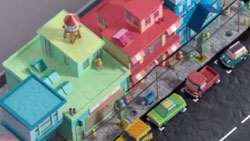
Cute iPhone diorama graduation project by Mike Ko.
Posted on Motionographer


MPS is the realization of an idea of pushing projection mapping one step forward, making it even more spectacular and involving. In short, we have synchronized rotation of stepped motor engine with “geometric” projection with respect to the position of the viewer. This is the moment where we get the spectator to “believe” that this is a metallic, weird box rotating in a front of the window of the skyscraper. It was shocking to me when I made a very first panel to show our friends that Vimeo flick. Most of them — like 80% — thought it was all post-production, a 3d animation (the industry three of us have come from) and Arek Rekita is just keyed-in there. So imagine theMore is coming, too. Rafal tells CDM, “in the near future, we will presents our in-house software for semiautomatic projector/3d calibration and others.” Yes. We’ll look forward to that.
sensation when you are actually standing in front of it. Its physical form there is real, and I think you can sense those qualities even through the computer’s screen.
The ability to visually influence human beings is weakening. We are getting more and more resistant to that form of communication. (When was the last time you heard heard that a movie had “good CG FC, really, go see it”?) In the film industry, I hope we are getting back to the era of a good script over spectacular effects, but in advertising, there is a whole new world coming in. I could rant about it for hours, so lets get back to MPS. The upper projection surface part is a 50 kg vinyl polymer structure, reaching 3.5 m in height. The base is a custom-made device from certified components, mainly stepper motor connected and controlled via Arduino.
The PC has twin GeForce cards driving three projectors – Benq W1100 and wide-lens Mitsubishi 230u-st. That worked well, but the system also worked with Christie Roadster monsters not in this video. Of course, we went for Derivative TouchDesigner as our interactive visual programming environment. It was a spectacular
learning process, adapting third-party libraries, synchronizing devices, and writing tools to quicken calibration processes. Yeah, we developed our own calibration software: it’s a semi-automatic little tool with live quality. We are going to introduce it on our Facebook profile soon. Stay tuned.
MPS project.White Kanga is based in Warsaw.
Realtime projection+servo+augmented reality.
Rafal Bielski : Programming, CG
Arek Rekita: Programming, Devices
Rafal Osmolski: Support
Patterned by Nature was commissioned by the North Carolina Museum of Natural Sciences for the newly-built Nature Research Center in Raleigh, North Carolina. The exhibit celebrates our abstraction of nature’s infinite complexity into patterns through the scientific process, and through our perceptions. It brings to light the similarity of patterns in our universe, across all scales of space and time.
10 feet wide and 90 feet in length, this sculptural ribbon winds through the five story atrium of the museum and is made of 3600 tiles of LCD glass. It runs on roughly 75 watts, less power than a laptop computer. Animations are created by independently varying the transparency of each piece of glass.
The content cycles through twenty programs, ranging from clouds to rain drops to colonies of bacteria to flocking birds to geese to cuttlefish skin to pulsating black holes. The animations were created through a combination of algorithmic software modeling of natural phenomena and compositing of actual footage.
An eight channel soundtrack accompanies the animations on the ribbon, giving visitors clues to the identity of the pixelated movements. In addition, two screens show high resolution imagery and text revealing the content on the ribbon at any moment.
Patterned by Nature was created by
Plebian Design – plebiandesign.com
Hypersonic Design & Engineering – hypersoniced.com
and
Sosolimited – sosolimited.com